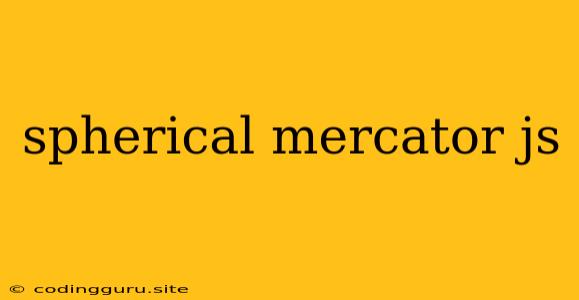Understanding and Implementing Spherical Mercator in JavaScript
The world is not flat, but most maps we interact with on the web are. This is due to the widespread use of the spherical mercator projection, a key component of web mapping applications that allows us to render geographic data onto a flat surface. While this projection introduces distortions, particularly at higher latitudes, it's efficient and well-suited for online mapping.
What is Spherical Mercator?
Spherical mercator, also known as Web Mercator, is a cylindrical map projection that transforms geographic coordinates (latitude and longitude) into planar coordinates (x and y). It is a variant of the Mercator projection which was originally developed for navigation purposes.
Here's how it works:
- Projecting the Earth onto a Cylinder: Imagine wrapping a cylinder around the Earth at the equator. You then project points on the Earth's surface onto the cylinder, like shining a light through the Earth and casting its shadow onto the cylinder.
- Unwrapping the Cylinder: Unwrap the cylinder, and you have a flat map.
This projection maintains angles and shapes locally, making it useful for navigation. However, it introduces significant distortion in areas further away from the equator. For instance, Greenland appears much larger than it actually is on a spherical mercator map.
Why is Spherical Mercator Important for JavaScript?
Spherical mercator is a core concept in web mapping libraries and frameworks. It allows developers to:
- Display geographic data: Render map tiles, points, lines, and polygons on a web map.
- Perform geographic calculations: Calculate distances, areas, and bearings using projected coordinates.
- Integrate with mapping services: Interact with APIs from popular providers like Google Maps and OpenStreetMap.
Implementing Spherical Mercator in JavaScript
While understanding spherical mercator is crucial, directly implementing the projection calculations is rarely necessary. Many JavaScript libraries handle the projection internally, making your development process smoother.
Here are some popular libraries:
- Leaflet: A lightweight and versatile JavaScript library for interactive maps.
- OpenLayers: A robust library with extensive functionality for advanced mapping applications.
- Mapbox GL JS: A powerful JavaScript library for building high-performance interactive maps.
These libraries provide functions for converting geographic coordinates to spherical mercator and vice versa. They also handle rendering, interaction, and other features related to mapping.
Example: Using Leaflet for Spherical Mercator
Let's illustrate using Leaflet to display a marker on a map using spherical mercator.
// Initialize a map centered on New York City
const map = L.map('map').setView([40.7128, -74.0060], 13);
// Add a tile layer from OpenStreetMap
L.tileLayer('https://{s}.tile.openstreetmap.org/{z}/{x}/{y}.png', {
attribution: '© OpenStreetMap contributors'
}).addTo(map);
// Add a marker at the Empire State Building
L.marker([40.7484, -73.9857]).addTo(map)
.bindPopup("Empire State Building").openPopup();
This code snippet initializes a Leaflet map, adds an OpenStreetMap tile layer, and places a marker at the Empire State Building's coordinates. Leaflet internally handles the conversion from geographic coordinates to spherical mercator for rendering the map and marker.
Considerations for Spherical Mercator
- Distortions: Always be aware of the distortions introduced by spherical mercator, especially at higher latitudes.
- Performance: While efficient, large datasets can still impact performance. Optimize rendering and calculations for smooth user experience.
- Alternatives: For applications where distortions are unacceptable, consider alternative projections like Equirectangular or Lambert Conformal Conic.
Conclusion
Spherical mercator is a cornerstone of web mapping, enabling seamless integration of geographic data into web applications. While it introduces distortions, it is widely used due to its efficiency and compatibility with popular mapping services. By utilizing JavaScript libraries like Leaflet, OpenLayers, or Mapbox GL JS, developers can leverage the power of spherical mercator without delving into the complexities of its implementation.
